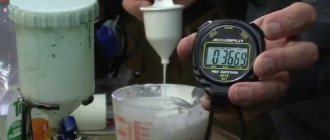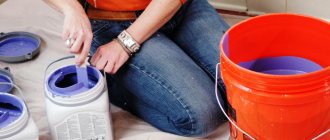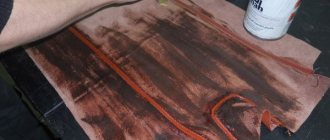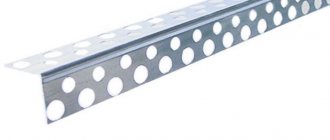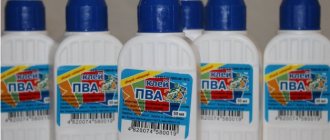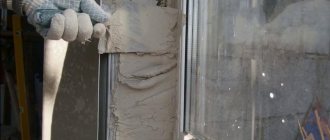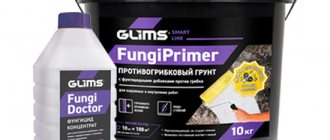The construction of a brick stove or fireplace, with proper planning, should end with finishing work, plastering and painting the outer surface. Most owners of stone stoves will agree that the porous, rough surface of brick walls quickly “grabs” soot and dirt, so the masonry is subjected to additional finishing. You can use traditional whitewash recipes or modern dyeing materials. All that remains is to find out whether it is possible to paint the stove with something like water-based paint so that the coating is durable and at the same time attractive.
Types of oven paints
Proper laying of a Russian stove with sufficient thickness of the hearth walls is a guarantee of uniform heating of the room.
But it's not only that. The air temperature in it also depends on what the oven is covered with. It is also necessary to take into account the fact that a rough surface has greater heat transfer than a smooth surface, despite the fact that the temperature of the outer part of the furnace can rise to 80C. For these purposes, many prefer to use enamel and oil compositions. This paint does not interfere with the generation of heat, and it is recommended to give preference to a rich dark color. Aluminum and other shiny compounds will not be effective due to their low thermal conductivity properties.
Synthetic paints are widely used, but it is better not to use oil-based paints. Due to the natural drying oil they contain, hot spots painted by them noticeably darken over time. The paint and varnish industry offers a large selection of special paints designed for stoves and fireplaces that have increased heat resistance.
The color palette of the listed options is not rich, and if it does not suit your taste preferences, you can use latex coating. In this case, painting the stove will be effective only after a rough primer.
Special paints and varnishes for the oven
- natural drying oil;
- varnish;
- silicone enamel;
- heat-resistant paint.
These compositions are produced industrially and are available for free sale. But some materials can be made independently; we will also talk about them in our article.
Only natural drying oil is used. Its distinctive quality is that it does not change the color of the brick, but only makes its shade darker. It is used only for painting a red brick stove in a bathhouse; the stove must be lit and run for at least 2 hours, after which it can be painted. We do not recommend using it indoors - here the stove heats up less and the drying oil may not dry out.
Photo 5. Example of a varnished stove
Note! The main feature of using varnish is the ability to add dry gouache to the composition and give the coating the required shade
- excellent adhesion to brick base;
- good strength;
- moisture resistance;
- long service life.
Among the shortcomings, only a small selection of colors can be noted.
Heat resistant paint
The main advantages are resistance to high temperatures (up to 600 °C) and a wide range of shades. They are used for painting steam pipes, so if you have not yet decided how to cover a red brick stove, then heat-resistant paint will be the ideal solution.
We suggest you read: How to paint a cabinet with chalk paint
Choosing a water-based dye for stove decor
Several water-based dyes make up the group of water-based paints. Manufacturers produce water-based emulsion:
- acrylic dye based on PVA;
- acrylic and latex;
- silicates;
- silicate composition.
Based on an emulsion of PVA and butadiene styrene, a water-based oven emulsion cannot be applied. On the surface of a hot structure, both compounds will crack and lose their white color. Other water-based compositions tolerate high temperatures.
Process technology
Painting a stove with water-based paint is not much different from applying a suspension to an ordinary brick wall, and it is quite possible to do it yourself. It all starts with preparatory work.
Preparation
Instructions:
- We prepare the necessary tools and materials:
- Brushes of different sizes. Will be needed for painting small parts and hard-to-reach places.
- A roller for covering an open, flat surface with paint.
- Bath for solution. This special container has a ribbed surface to squeeze out excess paint.
- Sandpaper and wire brush.
- The stove paint and primer itself.
- We clean the surface from debris and dust.
- We clean the seams between the bricks with a wire brush.
- We fill any existing cracks with putty. After it hardens, we rub it in, leveling it to the level of the brick.
- We prime the walls of the oven in several layers. This is a very important point, especially when working with water-based emulsion, because it provides the following:
- High adhesion rate. The paint will adhere to the brick more reliably.
- Closing pores, thereby reducing moisture absorption of the material.
- Creation of a durable polymer protective layer.
Tip: It is advisable to use a deep penetration primer. It will be much more effective than conventional mixtures in the case of brick.
Painting
After the primer mixture has completely hardened, stove paint can be applied:
- If you want to paint the seams and the bricks themselves in different colors for aesthetics, then first thoroughly stir the first mixture with water or white spirit in the proportions indicated on the can.
- Pour the required amount of liquid into the bath.
- Take a suitable brush and paint over all the gaps between the bricks. It is advisable that a lighter shade be used for this. Then, if the solution goes beyond the boundaries of the seams, it can easily be painted over with a second, darker paint.
- Next, mix the next solution with a mixture of a different color.
- We first run the tool along the ribbed surface of the bath and then apply paint to the stove, without pressing too hard. It is important to use a product made of foam rubber; it will slip through the seams without painting.
- If you paint the entire surface in one color, then simply take a sheepskin roller and, pressing firmly, paint the entire surface.
- If necessary, repeat the process several times until the most saturated shade is obtained.
- How to paint the inside of a microwave
How to paint correctly?
The paint is applied to the building in several layers.
When we have decided on the type of paint, we begin to prepare the surface.
To do this, use a scraper or a soft metal brush to remove uneven surfaces, dust, and dirt. To ensure that the paint is well distributed, it is recommended to further process the masonry with sandpaper.
To make the heating device heat resistant, the surface is treated with a special primer. When the masonry is completely dry, apply paint in 2-3 layers with a brush or roller.
When the main paint is completely dry, if desired, patterns and ornaments are applied to the surface of the brick oven.
Recommendations for stylish oven design
Nowadays, there is a clearly expressed trend towards naturalization of interior elements and details. One cannot ignore such a bright and imaginative component of the design as the stove. It emphasizes the color and Russian style, since it has long been considered an integral part of Russian life and culture. The growing passion for rustic styles (country, Provence, etc.) makes it possible to use a competent approach to painting a stove to turn it into a spectacular and colorful element of the home, emphasizing the refined taste of the owner.
A beautifully designed stove will add its own zest to the interior design
Even by covering the stove with transparent paint, you can turn it into a work of art. But, before painting a brick stove, you need to give it an appropriate, natural look. Having cleared it of dust and debris using putty, first eliminate all possible defects (cracks, damage, etc.). You can make your own putty by adding brick flour to latex paint.
What brands should I use?
- Tikkurila Luja. Resistant to wear. Can be used on any surface. Matte. Resistant to alcohol detergents. Price – 1700 rub.
- Lacra Super resistant. Suitable for use on brick, plaster and wooden surfaces. Drying time for the first layer is 1 hour, for the second – 2. Moisture-resistant and wear-resistant. Cost – 1100 rub.
- Parade F20. Forms a coating that is resistant to wear, moisture and fading. It is recommended to dry the layers within an hour, complete drying - after two hours. Do not paint at high humidity and room temperature below 10 degrees. Price – 1900 rub.
- DUFA D1A WANDFARBE. Withstands light loads. Creates a matte finish. Drying layers - 4 hours. Recommended application temperature is 20 degrees. Price – 1200.
- DULUX BINDO 20. Wear-resistant and moisture-resistant. Two layers are enough to cover. Drying time for layers is 1 hour. Washing with detergents is possible a month after dyeing. Price for 10 liters – 3900 rubles.
- TEX UNIVERSAL. Wear-resistant, moisture-resistant. It is possible to wash using non-abrasive products. Has a deep matte finish. Drying time of the layer is 3 hours. Cost – 1100 rub.
- TIKKURILA REPAIR Moisture-resistant, washable. Creates a semi-matte finish. One layer dries within two hours. Cost for 2.7 l – 1600 rubles.
- VGT VDAK 1180. Forms a matte surface, moisture-resistant, wear-resistant. Forms a special breathable coating. Does not lose color when exposed to ultraviolet light. The second layer can be applied after one hour, and complete drying occurs after 24 hours. Price 7 kg - 360 rub.
- MARSHALL. Easy to apply, dries within 4 hours. Moisture-resistant, wear-resistant. Suitable for painting by roller, brush or spray. Price for 2.5 l – 580 rub.
- Dali. Creates a moisture-repellent and dirt-repellent coating. Resistant to fading. The layers should be dried within an hour, complete drying occurs 2 hours after applying the last layer. Use at temperatures not lower than 10 degrees and normal humidity. The cost for 5 liters of paint is 1200 rubles.
We invite you to familiarize yourself with the earwig wing that inspired engineers to create a self-assembling origami
The best alkyd paints for heating radiators
Tikkurila Empire
The paint is offered by a well-known Finnish manufacturer. A ready-made concentrate and a special thinner, white spirit, are used. Alkyd paint is semi-matte and high quality.
- there is no risk of the slightest smudges when painting radiators;
- optimal adhesion to metal pipes is guaranteed;
- even the slightest odor is eliminated;
- there is the possibility of painting heating devices in the desired colors and shades;
- The paint layer is easily and quickly applied.
- requirements for indoor conditions (temperature should be from 5 degrees Celsius, air humidity – from 80%);
- thorough preparation of the radiator is required for further successful painting;
- relatively high consumption of the finished solution (10-12 liters per square meter).
SADOLIN MASTER 30
The Swedish manufacturer offers high-quality alkyd paint for metal batteries. The paintwork will have a semi-matte, pleasant shine.
- guaranteed protection of the surface from rotting, corrosive changes, mildew and mold;
- even the slightest smudges are eliminated when treating batteries with paint;
- there is increased resistance to atmospheric influences;
- provides abrasion resistance;
- fits perfectly on almost any surface;
- can be painted in any color and shade.
- has a smell (weak, but you will need to ventilate the room after the event);
- high price.
Professional Gloss JOHNSTONE'S
High-quality paint from a British manufacturer is ideal for working with metal heating devices. The product is based on a durable alkyd resin that helps create a durable coating.
- creating an ideal paint coating;
- pleasant shine due to the special texture of the paint;
- increased resistance to adverse external factors: temperature, shock.
When choosing paint, it is advisable to take into account the features of its composition and main characteristics.
- Oil paints are offered at affordable prices. In addition, their range surprises with its diversity. You need to prepare for a long drying time and an unpleasant odor.
- Acrylic paints dry quickly and are odorless. However, the perfect color is not always obtained.
- Alkyd paints have increased resistance to high temperatures and adverse mechanical factors. However, when painting, there is a pronounced smell. In addition, it takes a long time to dry.
- Heat-resistant paints are ideal for hot batteries, because they do not turn yellow and can withstand even the highest temperatures.
There are a variety of battery paints available these days, so it is important to carefully review the available products, their features, pros and cons. By choosing the right paint and taking into account the basic recommendations when applying it, you can count on successfully updating the condition of your heating radiators
What paints can be used to paint a brick stove in a house?
This type of paint adheres well to the surface of brick and can withstand high temperatures.
For brick kilns, types of paints are used that have heat-resistant, fireproof and toxicologically safe characteristics:
- Silicate. The material is based on liquid glass, mineral pigments and fillers. This is a heat-resistant paint that applies smoothly to the surface and does not require the use of special application techniques.
- Silicone enamel and varnish. This material withstands high temperatures better, does not crack, and retains the original appearance of a Russian stove for a long time. The products are thick in consistency, so they must be diluted before painting.
- Acrylic water-dispersion. The paint is based on water and acrylic dispersion. The material can withstand extreme temperatures, is elastic and durable.
- Fire-resistant paint materials and thermovarnishes for metal elements. The products consist of silicone resins; aluminum shavings are added to give the coating a glossy finish. Such paints are suitable for finishing the internal parts of cast iron or metal boilers, because they can withstand the temperature of an open flame and the red heat of steel.
What is powder coating
Powder painting is a method of applying a polymer coating to a metal product for additional protection and a decorative effect. The powder painting method involves applying positively charged particles to a previously cleaned object (which needs to be painted), followed by firing in a temperature chamber (170-250 C, depending on the type of powder). In simple words, it is a powder that sticks to the radiator and melts under high temperature. Unlike liquid analogues, powder paint applies evenly to the surface, has no odor, creates a durable impact-protective film and paints even the most difficult-to-reach radiator elements.
Which paint to choose
You have finally decided to carry out the necessary work aimed at restoring the device - the stove. It is important, first of all, to choose the appropriate paint. As a rule, water-based is best suited for this event.
Painting will require from you those parameters that are necessary for the stove to work efficiently, for example, only water-based paint (we see it in the photo) will allow a material such as brick to “breathe” properly.
Water-based paint itself is a popular dispersion material that is actively used to paint walls or ceiling surfaces. However, recently, water-based paint has been actively used for DIY work related to home stoves.
Pros and cons of heat-resistant paint
- Wear resistance, good heat transfer , protective functions of masonry. The painting process is easy, without primer, warranty period is 10 years .
- Strong odor, long drying time, toxic substances in the composition . When doing work with your own hands, precautions should be taken.
Having chosen what to paint the stove with , you should carefully consider this process, and especially the choice of paint . When purchasing, it is better to immediately select a solvent, since the paint may dry out or accidentally get on other surfaces.
is better not to use used brushes due to the difference in components, especially for homemade .
Paint for steel elements
Painting the stove door
In addition to bricks, the oven also contains iron parts. What is the best way to paint them? This issue should be approached from the point of view of material protection.
In this case, a flame can threaten its integrity, and if we are talking about a bathhouse, then also water.
- Fire. To increase fire safety, fire-retardant paints for metal Polistil are suitable, which have the properties of foaming when a fire occurs, preventing its spread. Since cases vary, and the stove is a fire hazard, it won’t hurt to be on the safe side.
- High humidity. Electrically conductive paint Zinga can cope with this problem perfectly, creating a reliable thin-film layer of galvanization. The absence of rust is then guaranteed.
Painting a stove with water-based paint is not much different from applying a suspension to an ordinary brick wall, and it is quite possible to do it yourself. It all starts with preparatory work.
Cladding methods
If you don’t know what to paint the structure with, you can finish the existing fireplace using one of the methods presented below:
- Plaster and then apply water-based paint.
- Simply paint without pre-coating with anything.
- Coat the stove surface with a varnish that is resistant to high temperatures.
- Apply a pattern with a relief to the brickwork, and then secure it with a special varnish coating.
If you paint the fireplace as presented in the last version, it will significantly change its appearance, become more aesthetically pleasing and attractive, while the coating itself will not lose its original appearance for many years.
General provisions
Water-based paint for stoves in cans
The water emulsion uses ordinary water as its base, filled with insoluble tiny particles of polymers for binding and pigments for color. It was invented relatively recently, in the last century. But a significant list of advantages easily made it one of the world's favorites among paints and varnishes.
- Affordable price. Despite the technical superiority, for example, over traditional oil suspensions, water-based paints are cheaper due to less expensive raw materials.
- Short curing term. The sooner the work is completed, the better.
Tip: it is recommended to paint at a constant temperature of about five degrees Celsius. This will ensure that the solution dries almost instantly.
- Easy to apply with your own hands. The applied layer lays down evenly and has no smudges.
We invite you to familiarize yourself with How to store tulip bulbs: 4 methods proven in practice
Whitewashing a stove with water-based paint using a roller
- Ecological safety of the composition and absence of unpleasant odors. During the drying process, the only thing that is released is water vapor, which cannot harm human health in any way.
- Wide range of colors. Moreover, there is the possibility of tinting the paint, that is, mixing different colors to obtain the desired shade.
Color palette of possible shades
Advice: it is recommended to mix not by hand, but using a special tinting machine. Because this is the only way you can repeat the desired color if you need a new portion of the suspension.
Example of a tinting machine for mixing paints of different colors
- Heat resistance and fire safety. Due to the base consisting of H2O, the water-based emulsion perfectly withstands high temperatures and even direct exposure to flame.
- Moisture resistance. In addition to heat, paint for a sauna stove must also be able to withstand high humidity, which is always present in a Russian steam room.
- Resistance to mechanical damage. The reliable polymer layer is not afraid of accidental scratches.
- Durability. The service life reaches up to ten years.
- Washable. Removing traces of dust and soot is not difficult.
Thus, the answer to the question of whether it is possible to paint the stove with water-based paint has been given comprehensively.
What kind of brick is used to lay the stove?
Sometimes there is a need to update the appearance of a brick-lined stove. What to do here, how to paint a brick stove in a country house or in a bathhouse, provided that the finishing work will be done with your own hands. If you have a question about how to paint a red brick stove, we will try to help you.
You can successfully use lime whitewash with the thickness of liquid sour cream. But there are also special paints designed for painting brick.
Painted brick
Before purchasing paint, be sure to check that it is heat-resistant. Silicon-organic enamel is suitable; it can withstand temperatures of about 600°C. The following brands of silicon-organic paints are available for sale:
- KO-168
- KO-174
- KO-813
- KO-835A
- KO-1112
To dissolve these enamels, you can use turpentine or solvent 646. To obtain a good result, the paint must be applied in 2 - 3 approaches in as thin a layer as possible. This will prevent the formation of smudges.
The resulting mixture is transparent with a slight haze. To get the color you require, proceed as follows:
- Take gouache of the required color and dry it well.
- Dry gouache is ground to form a fine powder.
- Dry gouache powder is added to the varnish and turpentine mixture until the desired shade is obtained. Can be painted.
Photo 1. Brick kiln at the laying stage
For lining the combustion chamber, predominantly fireclay refractory material is used (see photo 2), which is resistant to open flames and can withstand temperatures up to 1500 °C. A prerequisite is the use of products of the same type in masonry, since different materials (for example, ША and ШБ or expensive and cheap) have different thermal expansion.
Photo 2. Fireclay brick
It is more expedient to lay the furnace mass using solid red brick (see photo 3) of grades M150-M250 with a density in the range of 1600-1900 kg/m3. A higher density impairs the bonding of the clay-based mortar and increases the heating time of the masonry material. Products must be high-quality fired, have the correct geometry and exact dimensions.
Photo 3. Red ceramic solid brick
It is allowed to use clinker material for lining the furnace (see photo 4). It is produced by firing at a temperature within 1200 °C, so the thermal effect is not critical for it, especially since the facing layer is subject to heating to a lesser extent than the solid wood. In this case, the question of how to refine a red brick stove disappears by itself, since clinker lining looks more aesthetically pleasing than any other type of finishing.
But things don't always happen the way we want them to. Sometimes, due to design features, limited budget or a number of other reasons, it is necessary to look for alternative improvement options. There are quite a few of them, but first let’s figure out what it’s for.
Painting a stove with water-based paint: do-it-yourself painting instructions, video and photos
Wood-burning stoves are still widespread today, despite widespread urbanization.
They have found their successful use in bath structures and are the only source of heat in many country estates. Caring for the stove, among other things, also involves painting it in a timely manner.
This is done to give the structure aesthetics and increase its heat transfer qualities.
Water-based paint will do the job perfectly. And we will look at how to paint the stove in the house with its help in this article.
Photo of a painted brick oven
Criterias of choice
There are a lot of paint and varnish products in construction stores. If you are not knowledgeable about paints, pay special attention to the information on the packaging. Basic information:
- compound;
- appointment;
- humidity indicators;
- manufacturer;
- price.
There are various varnishes, paints, enamels that have a high-quality composition, but are not suitable for a home brick oven, but are intended exclusively for industrial premises or the street. The packaging should be marked “heat resistant”.
When purchasing paint, you should make sure that it has a certificate. Dubious products are created from untested ingredients, which can lead to loss of health, not to mention the attractiveness of the paintwork. High-quality paint cannot cost less than 135 rubles per kg.
When considering options for painting a brick stove in your home, it is important to pay attention to the temperature indicator declared by the manufacturer and the protective functions. You should choose those brands that are offered by companies that have their own factories for the production of paints and varnishes and quality control.
Organosilicon enamels of different companies, variants and shades Source 2gis.com
Features of the use of water-based compositions
To be precise, modern water-based materials are not far removed from classic lime and chalk solutions for whitewashing hot surfaces. But there are still differences:
- The presence of a polymer binder in the paint, even in a relatively small amount, increases adhesion to the base of the stove surface by an order of magnitude. Thanks to this, the stove can be painted with paint that is relatively liquid in consistency, without the risk of streaks or smudges;
- The use of surfactants and mixture stabilizers ensures a low surface tension coefficient, as a result of which the water-emulsion solution penetrates deeply into the pores of the surface;
- High resistance to oxidation and heat.
The smell of water-based paint is different in nature from the smell of alkyd or even silicon organic enamels. Alkyd masses harden due to the volatilization of the solvent, without changing the polymer base. Dried paint can be heated and easily removed from the substrate.
If you paint the stove with water-based paint, the water-polymer base will intensively absorb oxygen from the air, oxidize and become insoluble. The stronger the heating, the faster the cementation process occurs, the sharper the smell, which is absolutely harmless and quickly evaporates.
What to look for when choosing paint
Often, many home owners, when choosing paint for the stove, pay great attention to taste preferences, forgetting about its quality characteristics. The paint must be heat-resistant, only in this case it will satisfy all the needs and wishes of consumers. Organosilicon enamel, for example, has such properties. It retains them even when the surface is heated to 600C. Its solvents can be turpentine or 646 solvent. Apply it 2-3 times after the previous layer has completely dried.
Advantages of heat-resistant paint:
- it has excellent wear resistance and heat resistance;
- such a coating has electrical insulating properties;
- with its help, brickwork is protected from oxidation, which increases its strength and endurance;
- The painting process is simple and does not require preliminary priming;
- The shelf life of its operational characteristics is long - about 10 years.
Disadvantages of heat-resistant paint:
- the composition has quite aggressive properties, which can be dangerous to the health of humans and domestic animals;
- the paint has an unpleasant odor, which makes it impossible to use it in a house where people with respiratory problems live;
- the compositions have a long drying period, which may be associated with certain inconveniences;
- The presence of toxic substances in their composition makes it mandatory to use respiratory protection and skin surface protection during work.
Heat-resistant paint is toxic and very harmful to health
Advantages and disadvantages
Painting the surface of the furnace with a product with water-based characteristics has its own characteristics and disadvantages.
Pros:
- Heat resistance. This paint can withstand high temperatures.
- Moisture resistance. The coloring substance protects the stove device from moisture from the room. This feature will be very necessary in the steam rooms of baths and saunas. It can be washed and cleaned using water-based products and without fear of losing its attractive appearance.
- Strength. The coating can withstand minor scratches and slight pressure from the external environment.
- Minimum cost. Covering the stove with tiles or other interior solutions will cost you much more. Painting the stove with water-based paint is a relatively cheap, but also very beautiful way to update your stove.
- Ease of use. The coloring agent is applied quickly and easily. In just a few hours the oven will have a new look.
- Drying time. The drying time of the layers is short. No additional time is needed to start heating the room.
- Environmental friendliness. The paint base is non-toxic and suitable for use in residential areas.
- Big choice. In specialized stores you will find a huge number of different water-based paints in all colors of the rainbow. This choice provides you with the opportunity to create a unique design.
We invite you to familiarize yourself with Eleutherococcus - benefits, harm, application, treatment recipes
Minuses:
- Unpleasant odor during drying. But during the operation of the furnace it is not observed.
- The paint penetrates quite deeply into the pores of the brick. But this problem can be solved with a layer of primer or putty.
- In places of strong heat, it may change color or peel off.
Positive and negative qualities of CM for furnace processing
The choice is made on water-based paint due to its technical characteristics:
- Overheat tolerance - heat resistance of the dye.
- The coating has high moisture resistance. The design of the heat source is protected from moisture in the room. This is especially important in the sauna and bathhouse. In addition, the surface can be washed with detergents and there is no fear that its appearance will be damaged.
- The covering layer can withstand mechanical stress and has a high level of strength.
- The low price allows you to decorate the stove quickly and economically.
- The material is easy to work with.
- High drying speed of the coating. The heating structure can be used fairly quickly after updating.
- KM refers to safe compounds. It is used for interior work.
- The range of colors of water-based paints makes it possible to implement any design idea.
Disadvantages must be taken into account in order to reduce problems encountered when working with the material:
- The new coating emits an unpleasant odor as it dries. But when it completely polymerizes, the smell goes away.
- Taking into account the deep penetration of CM into the structure of the brick, the surface is pre-treated with a primer, which is sometimes replaced with putty.
Using water-based emulsion for painting a stove
The category of water-based paints includes all water-based paints with a mineral pigment filler and a small amount of organic liquid binders made from acrylic, methacrylic and vinyl polymers.
A water-based paint composition can be used to paint both metal and plastic, glass, brick, plaster and concrete with equal success. Most often, water-based paints based on acrylic and modified synthetic rubber are used for interior work. Vinyl fillers are used less frequently due to their poor resistance to elevated temperatures.
Choosing the type of painting
Painting with chalk or lime – the base of a brick (stove or fireplace) can be painted with your own hands using limestone whitewash. When mixing the composition (100 grams of lime, 40 grams of salt diluted in water), it should resemble liquid sour cream .
Before painting, the surface of the fireplace must be prepared, cleaned of dirt and dust using a scraper or spatula. Uneven areas must be filled with putty (brick flour and latex paint). If the question is: “ How to paint the stove?” “If you are inclined towards more modern methods, then when choosing paint the main emphasis should be on its heat resistance.
Painting with oil or enamel paints will increase heat transfer; it is better to choose a dark color, such a surface gives off more heat. You should not choose glossy or smooth surfaces; they can significantly reduce efficiency.
Water-based paint is a common option, applicable to brick and concrete surfaces, plaster or drywall. Dries quickly, safe, easy to apply with a brush or roller, easy to choose the right shade. Disadvantages - speed of absorption and price (higher than other means for upgrading the stove).
If the stove is manufactured to the required standards, then surface heating can
reach 80 degrees . For such temperatures, synthetic-based paints are suitable - nitro paints, pentaphthalic paints . If the paint base contains drying oil, it may darken at temperature .
Heat-resistant paints sold in stores have good heat transfer, but their palette is not large. If the colors presented do not suit you, then you can paint the brick stove with latex paint after preliminary priming.
Silicon-organic enamel is heat-resistant, durable, this paint should be applied in a thin, even layer, for optimal color in 2-3 layers .
Homemade varnish
At home or in the country, you can whitewash the stove with paint prepared at home and using safe materials. A homemade solution is prepared in this way:
To make homemade paint you will need egg whites.
- Grind the red brick to a powder, then sift through a sieve.
- Add egg whites and fresh milk to the powder until the consistency of the mixture resembles thick sour cream.
- Mix the ingredients well.
The solution is applied to a warm surface, after which it is recommended to additionally coat the brick with drying oil or varnish.
This coating will last a long time because the mortar protects the brick blocks from cracking and abrasion.
This option will look great in an interior with natural accents.
To prevent the brick stove surface from getting dirty, it is recommended to first heat the device well, and when it is hot, apply a thick layer of beaten egg whites. Then the whitewash will remain clean for a long time, and any dirt can be wiped off with a damp towel.
Chalk or lime
Whitewashing the stove with chalk and lime has been known since the very beginning of Russian society. All you need for this today is to take 50 grams of salt and dilute it with 1 kilogram of lime. Next, dissolve this mixture in water until creamy. It is better to use low-fat milk instead of water.
As for chalk, you need to crush it and pour several liters of milk into 1 kilogram of the composition. It is worth noting that it is necessary to add 50 milliliters of blue. This is necessary so that during use the white stove does not turn yellow or look like bronze. The prepared high-temperature mixture in the first and second cases should be used as quickly as possible before the composition hardens.
How and how to paint a metal stove
To decorate cast iron and steel hearths, you need paint for fireplaces and stoves, suitable for working with metals.
Metal walls heat up more than stone and brick walls, so it is better to choose compounds with high heat resistance.
The heat resistance of enamels is easy to determine by special markings.
- KO-811 – anti-corrosion compounds for metal surfaces.
- KO-813 is an anti-corrosion enamel that can withstand temperatures from -60 to 500 degrees.
- KO-814 – enamel, resistant to salts and oils, can be used at temperatures from -60 to 400 degrees.
- KO-8111 is a durable heat-resistant enamel for painting surfaces heated to 600 degrees.
Enamel for metal furnace equipment
Before painting the stove, the metal is thoroughly cleaned with sandpaper, wiped off any remaining dust and degreased with solvents.
Areas that do not need painting are protected with thick paper or newspaper.
The paint is applied directly to the metal without a primer; it is more convenient to use aerosol cans for this.
Instead of painting a steel furnace, you can use the metal bluing method - this treatment reliably protects against corrosion and gives the surface a very impressive look for a long time. Burnishing involves chemical treatment with a mixture of acids and alcohol.
Preparatory work
It is necessary to prepare the surface for painting in advance. The quality of the coating depends on this.
When preparing a radiator for painting, perform the following work:
- First you need to clean the heater from dirt.
- The battery is then inspected to look for rust.
- Then, using a scraper and sandpaper, remove the old paint.
- After the surface of the battery is cleared of the old coating, the battery is treated with a primer solution.
- Then a primer is applied, this will level the coating, remove unevenness, and ensure adhesion of the paint to the surface.
- The primer is chosen depending on the type of paint.
- The work area is covered with cellophane, and both the floor and the wall should be covered.
To prepare a chemical composition for paint removal you need to prepare:
- 1 kg of calcined salt;
- 1 kg lime;
- 5 liters of water.
The washing solution is prepared as follows: pour hot water into a 10-liter container, add soda, stir it, add lime in small portions, mix the solution and leave for 10-15 minutes. This solution is applied to the heating device, left for 5-10 minutes, and then the paint is removed with a scraper.
The mechanical method of removing paint from a radiator is based on the use of a drill with an attachment. During work, do not press hard so as not to damage the metal. When the preparatory work is completed, painting begins.
Conclusion
Painting your stove will help you update and improve its appearance, protect the material of its walls, and even improve heat capacity by increasing the integrity of the coating. The most suitable paint for this task, due to the combination of its advantages, is a water-based paint.
It is very easy to work with, but before doing this it is necessary to carefully prepare the surface to be treated, especially prime it thoroughly. Then, using brushes and a roller, a suspension of one or two colors of your choice is applied.
The video in this article will provide you with additional materials on the topic in question.
High-quality painting will make the stove the main highlight of your home.
nashaotdelka.ru

